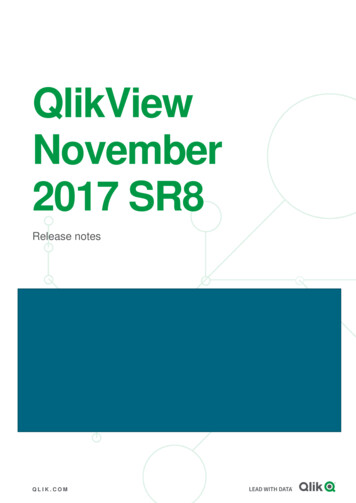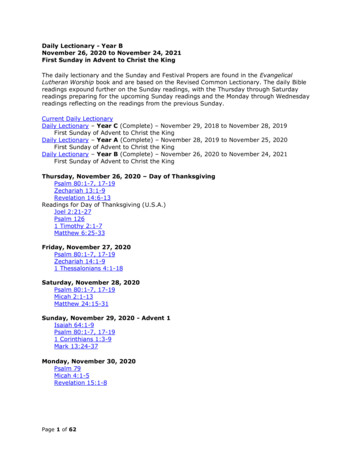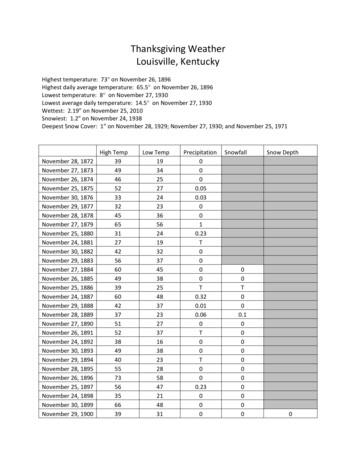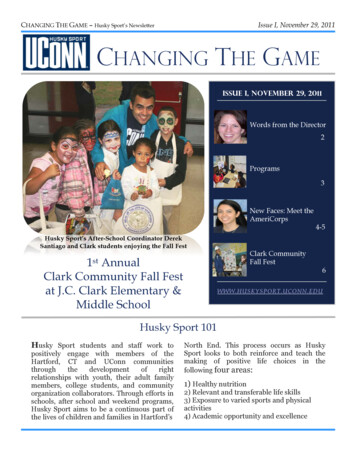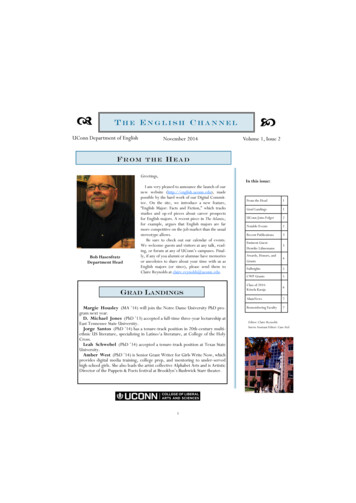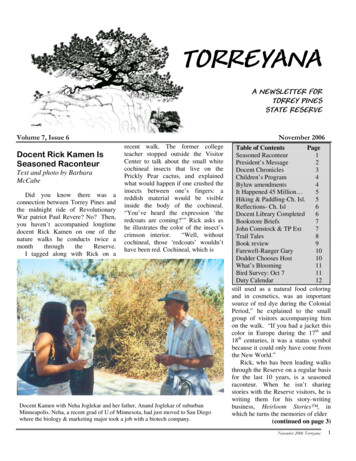
Transcription
TORREYANAA NEWSLETTER FORTORREY PINESSTATE RESERVEVolume 7, Issue 6Docent Rick Kamen IsSeasoned RaconteurText and photo by BarbaraMcCabeDid you know there was aconnection between Torrey Pines andthe midnight ride of RevolutionaryWar patriot Paul Revere? No? Then,you haven’t accompanied longtimedocent Rick Kamen on one of thenature walks he conducts twice amonththroughtheReserve.I tagged along with Rick on aNovember 2006recent walk. The former collegeteacher stopped outside the VisitorCenter to talk about the small whitecochineal insects that live on thePrickly Pear cactus, and explainedwhat would happen if one crushed theinsects between one’s fingers: areddish material would be visibleinside the body of the cochineal.“You’ve heard the expression ‘theredcoats are coming?’” Rick asks ashe illustrates the color of the insect’scrimson interior.“Well, withoutcochineal, those ‘redcoats’ wouldn’thave been red. Cochineal, which isDocent Kamen with Neha Joglekar and her father, Anand Joglekar of suburbanMinneapolis. Neha, a recent grad of U.of Minnesota, had just moved to San Diegowhere the biology & marketing major took a job with a biotech company.Table of ContentsPageSeasoned Raconteur1President’s Message2Docent Chronicles3Children’s Program4Bylaw amendments4It Happened 45 Million 5Hiking & Paddling-Ch. Isl.5Reflections- Ch. Isl6Docent Library Completed6Bookstore Briefs7John Comstock & TP Ext7Trail Tales8Book review9Farewell-Ranger Gary10Dodder Chooses Host10What’s Blooming11Bird Survey: Oct 711Duty Calendar12still used as a natural food coloringand in cosmetics, was an importantsource of red dye during the ColonialPeriod,” he explained to the smallgroup of visitors accompanying himon the walk. “If you had a jacket thiscolor in Europe during the 17th and18th centuries, it was a status symbolbecause it could only have come fromthe New World.”Rick, who has been leading walksthrough the Reserve on a regular basisfor the last 10 years, is a seasonedraconteur. When he isn’t sharingstories with the Reserve visitors, he iswriting them for his story-writingbusiness, Heirloom Stories , inwhich he turns the memories of elder(continued on page 3)November 2006 Torreyana1
The Torrey Pines Docent Societypublishes the Torreyana bi-monthly. Itemsfor publication may be submitted to VictoriaSchaffer, victoria1906@roadrunner.com orleft in the Torreyana mailbox at the Lodge. Inalternate months, TPDS publishes the TorreyPinecone, edited by Walt Desmond. ThePinecone includes the monthly duty calendar,announcements and information concerningmembership meetings. Items for publicationin the Pinecone should be e-mailed tow.desmond@sbcglobal.net . Submissionsfor either publication are due on or about the20th day of the preceding month.Please send postal address changes to:Torrey Pines Docent SocietyP.O. Box 2414, Del Mar, CA 92014Attn: Jean SmithE-mail changes to Jeannie@ucsd.eduWeb sites:TPDS www.torreypinesreserve.orgTPA www.torreypines.orgTPDS Board Members:President, Steve UsherVice-president, Tom PolakiewiczTreasurer, Rick VogelSecretary, Barbara McCardleDir. of Communications, Roger IsaacsonDir. of Children's Program, Cecily GoodeDir. of Programs, Christina BjenningDir. of Training, Jeff SpivakDirs. of Duty Coordination, Lillian Lachicotte& Irene LarrimoreTo obtain extra newsletters contactVernie McGowan.TPSR Staff:Supervising Ranger:Jody Kummer jkummer@parks.ca.govRangers: Kyle Knox, Gary Olsonand Mike WintertonPark Aides: Jamie Burton (senior aide), KateCochran, Laura Ohman, Louis Sands, MoiraReaganTP Visitor Center phone (858) 755-2063Torrey Pines Docent SocietySince 1975All rights reservedMany thanks to the docents contributing tothis newsletter and to Senior EditorVictoria Schaffer and Copy Editors JudySchulman and Walt Desmond. Many thanksto Vernie McGowan and Eva Armi for mailingand distribution.From the PresidentAs we approach our Annual Meeting, the Board has proposed threemajor issues for approval by the membership: two amendments to theBylaws and one significant expenditure. I would ask for your support on allthree of these issues.The first amendment to the Bylaws is to establish a new membershipstatus, that of Lifetime Member. The status is to reward the long-termcommitment and dedication of some of our members. It is the view of theBoard that anyone who has given a decade of loyal service to the Society andto the Reserve deserves our recognition and admiration. While LifetimeMembership will no longer require the payment of dues or the completion ofthe requisite annual hours, it is hoped that Lifetime Members would remainactive in the Society and at the Reserve. Although it has been argued thatLifetime status should require a commitment “over and above” the normalrequirements, I disagree. To me, a decade of volunteer service to this uniqueand beautiful site is itself evidence of commitment to the Society anddedication to the Reserve “over and above” what anyone else in our communityhas provided.The second amendment will bring our Bylaws in conformity with DPRregulations. We took the first step in this process last year, when the Boardvoted to authorize service hours for all the time spent in our monthly GeneralMeetings. This amendment to raise the requisite hours from 72 hours per yearto 96 hours per year simply completes the circle.Third, your Board is proposing that we join with TPA in donating 10,000 inseed money to the soon-to-be established Torrey Pines Endowment. Becausethe Docent Society was established as a service organization and not a fundraising entity, the TPA has taken the lead with this project. Assuming theDocent Society matches their donation, the TPA Board has agreed that we willhave an equal voice in determining how the income from the endowment is tobe spent. The endowment will be established within the auspices of the SanDiego Foundation. The Foundation supports the endowments of many nonprofit organizations in San Diego County including the Anza-BorregoEndowment Fund, the Bishop’s School Endowment Fund, the San Diego NavyLeague Fund and the San Diego Symphony Orchestra Fund. A group of outsidemanagers oversee the funds under the eyes of an investment committee. Theinvestment philosophy of the Foundation is to establish a diversified portfolioof moderate risk structured for long-term total return. The portfolio hasoutperformed its benchmark on a one quarter, one year, three year, five yearand ten year horizon.The Society currently has cash assets of approximately 86,000 heldprimarily in CDs and a money market account. This contribution wouldstrengthen the relationship with TPA as evidenced by our continuing financialsupport of the Reserve and commitment to the preservation of the Reserve.I look forward to a full discussion of all three of these issues at ourAnnual Meeting on November 18.Once again, thank you all for your dedication and hard work. See youaround the Reserve!Steve UsherPresident, Torrey Pines Docent SocietyRoger IsaacsonDirector of CommunicationsNovember 2006 Torreyana2
(Continued from page 1)family members into stories theirdescendants can treasure forever. Ricklaunched the business in 1999 afterpublishing Heirloom Stories from theHarnessmaker’s Son, a humorousbook of short stories told to him byhis father, Jack Kamen, the son ofRussian immigrants, who grew up inBrooklyn. “Having people genuinelyinterested in what you have to saykeeps you healthy,” says Kamen,noting that his ailing father lived foranother seven years after he beganrelating the family stories his sonturned into a book. “Elders lovetelling stories,” says the Clairemontresident, “but they’re not interested inwork, and writing Heirloom Stories is definitely work.”The stories Rick tells while leadingwalks through the Reserve have acommon denominator. They aredesigned to give visitors an experience of what it is like to be one of themany plants, animals and humansnative to this landscape. Byunderstanding what life is or was likefor them, visitors are more likely torealize the importance of preservingthis habitat. “I want people to knowhow it feels to be every one of theseliving things – even the plants,” heexplains. “Take Lemonade Berry, forexample. Some plants distribute theirseeds by surrounding them with soft,sweet fruit that tempts animals to eatthem and deposit them elsewhere in ‘apile of damp fertilizer.’ LemonadeBerry is ‘smart’ because it has figuredout a way to get furry creatures totransport its seeds without investingthe energy needed to produce fruit,”he explains. “When Lemonade Berryseeds are mature, they don’t hold onto their branches tightly. Whenanimals brush against them, seedsstick to their fur. Why? The seeds arecovered with a sticky, waxysubstance. The animal notices thebright red berry when it begins togroom itself and picks it off with hismouth,” he adds. “The animal spits itout right away because it tastesterrible, and the seed for anotherLemonade Berry plant has beendispersed.”If you want to hear more of Rick’sstories about Torrey Pines – and he’sgot dozens of them – take a walk withhim some Saturday. To find out moreabout the Heirloom Stories that hewrites, visit his website atwww.HeirloomStories.com.Docent ChroniclesOctober 06Excerpted from the October generalmeeting minutes. (Complete minutes,by Executive Board SecretaryBarbara McCardle, are in the docentlibrary.)Edited by Team TorreyanaDocents of the Month: Susan andTom Polakiewicz, for their manyhours of work while organizing theChannel Islands Field Trip.Children’s Program: Report by DianeGreening, for Cecily Goode. Allspaces have been filled by interestedschool groups. We need docents tosign up to lead groups. Dianecirculated sign-up sheets for October,November and December andencouraged docents to becomeinvolved with the Program.Duty: Tom Polakiewicz reported forLillian Lachicotte and Irene Larrimorethat there are some spots to fill forOctober. Roger Isaacson solicitedvolunteers for vacant spots for thisweekend.Communications: Roger Isaacsonreported that docents may opt out ofreceiving the newsletters by mail,saving postage costs and paper. AllDocents on the email list will receivea link to download the newsletters as apdf file from our Web site. If docentswant ONLY the electronic version,they could sign list at the meeting orshould respond to Jeannie Smith'semail. Docents will continue receivingnewsletters by regular mail UNLESSTHEY REQUEST THE ELECTRONIC VERSION ONLY. (At presstime 38 docents already signed up forthe electronic version only)Note: For online duty calendar viewing theDocent Login has been changed. Seemailed out copy for this information.Bookstore: Nancy Woodworthannounced that 500 copies of theBirds of Southern California CoastalBays and Estuaries brochure weregiven to the Society by the San ElijoConservancy. Free copies areavailable today. Brochures will beincluded in the docent trainingmanuals and will also be distributedduring Special Walks.Trail Patrol: Report by Paul Whitby.Trail Patrol members are required towear the new State insignia on theirvests. Docents should let Paul know ifthey wish to order the new insignia. Atour of Mission Trails Park is beingplanned for January; moreinformation will be available at thenext meeting. Another Trail PatrolTraining session may be held inDecember.Library: Report by Sharon and SteveRose. The remodel is complete. Aribbon cutting ceremony is plannedfor Saturday, October 28, 2006, at10:00 a.m. Books are back on theirnew shelves and DVDs and VHStapes will be available soon. DocentDawn Thieding agreed to keep theLibrary bulletin board current.Amendments to the Bylaws: The Boardvoted to enact two amendments to theBylaws. Board VP Tom Polakiewiczpresented the amendments at thegeneral meeting. See page 4 for textchanges. Discussion and voting willtake place at the November 18General Meeting. The firstamendment is to increase the requirednumber of docent volunteer hoursfrom 72 to 96, to reflect the Staterequirement. The second amendmentproposes to allow docents with tenyears of active service to qualify forHonorary Lifetime membershipshould they not be able to remain inactive status.Endowment with TPA: TPA has put up 10,000 in seed money to establish anendowment to be managed by the SanDiego Foundation. TPA voted to giveNovember 2006 Torreyana3
TPDS a full and equal vote regardinghow the endowment income will bespent, if the Society will match their 10,000 contribution. Discussion andformal vote will take place at theNovember meeting.Santa Rosa Island Update:Representative Duncan Hunter’sproposal to maintain a huntingoperation on Santa Rosa Islandbeyond the agreed 2011 terminationwas approved as an attachment to theNational Defense Authorization Actof 2007. Representative Lois Capps(D-Santa Barbara) will introducelegislation in the House next year tooppose Rep. Hunter’s proposal.Docent News: Long-standing docentDon Miller recently passed away. Amemorial service is scheduled forNovember 11, 2006, at Eternal HillsMemorial Park at 1:00 p.m. Don’swidow, Fran Obler, has asked thatdonations in Don’s memory be madeto the newly formed TPA Foundation.Docent Joellen Barnett, class of ’06,dropped out due to serious illness. Shehad volunteered to chair the WinterSolstice Party and anyone wishing toreplace her should contact JeffSpivak.Ranger’s Report: S. R. Jody Kummerannounced that Ranger Gary Olsonhas been promoted to SupervisingRanger for Old Town, startingDecember 1, 2006. TPA is interestedin remodeling the museum andRanger’s Office. Graduate studentsfrom the New School of Architectureare involved in a project that includesa new design. A committee is beingformed to oversee this project.Docents thanked the rangers forDocent Appreciation Night.Children’s ProgramContinuing EducationAll docents are welcome to shadowthe Children’s Program on Thursdaysand Fridays in preparation for leadingtheir own CP walks. Just show up andask someone if you can tag along! Ifyou are a current CP leader, trylearning at least one of the presentations by listening to different peoplepresenting it and taking notes. Whenyou’re ready, you can start by sharingthe presentation with someone who’sdone it before—no need to worryabout forgetting part of the program.Watch this CyberspaceWe might have a special training onNovember 10th, or take a group hike,or take the day off. Watch your emailsfrom Laura, our TPSR Coordinatorfor breaking news.Last but not LeastThanks to everyone who signed up tolead walks through the end of theyear. There are more spaces available,so if interested check your calendarand let Laura know when you canhelp. Her easy to remember email linkis ChildrensProgram@torreypine.orgDiane GreeningNext General MeetingNovember 18, 2006 9 a.m.atNational University just across thehighway from the Torrey Pines GolfCourse (15 min walk from theVisitor Center)11255 North Torrey Pines Road.Program: “Munching and Mating inthe Macrocystis” by Dr. Bill BushingDr. Bill Bushing has been a residentscientist on Santa Catalina Islandsince 1969. Bill became involved withprograms conducted by the JeanMichel Cousteau Institute, serving asa consultant, staff member and guestlecturer for Project Ocean SearchCatalina. Over the years he hasworked with Jean-Michel and hisfather, Jacques Yves Cousteau,through The Cousteau Society andOcean Futures. He writes a weeklynewspaper column, "Dive Dry withDr. Bill," on marine life and ecologyand has a daily local cable televisionprogram with the same name.www.StarThrower.org.December 2Lodge decoratingDecember 14Winter Solstice PartyTPDS Annual MeetingOur TPDS Annual Meeting will takeplace on November 18, starting at 9a.m. It is important that votingmembers attend this meeting andparticipate in two votes: Election ofthe TPDS Executive Board Officersfor the year 2007 and an amendmentto the TPDS Bylaws. The proposal isfor a change to the bylaws of theTorrey Pines Docent Society to createa new membership class, “LifetimeMembers.” Proposed changes areunderlined below:Article II (Membership)Section 2.A. Active Members. Annual duesshall be established by the ExecutiveBoard. Qualifications shall be to havepaid the annual dues, to havecompleted a prescribed course oftraining, and to perform the minimumprescribed hours of public serviceduties or equivalent service to furtherthe aims of the Society as determinedby the Executive Board ( 6 8 hoursmonthly or 72 96 hours per year).Insert the following as Article II,Section 2, paragraph D:D. Lifetime Members. Lifetimemembership is offered to docents whohave been active members for aminimum of ten years, but who are nolonger able to complete the servicerequirements of active members, yetwish to continue to support theactivities of the Docent Society.Active members who meet theminimum length of servicerequirement shall apply for Lifetimemembership, which will be grantedupon application. Lifetime membersmay, but are not required, to performpublic service activities with theSociety. Annual dues shall not berequired of lifetime members.Privileges are the same as for Activeand Supporting members. Lifetimemembers may remain in thismembership class for life.Renumber the remaining paragraphsof Article II, Section 2 as:(continued on next page)November 2006 Torreyana4
E. Honorary Members.F. Friends of the Torrey Pines State Reserve.The complete Society Bylaws are on the TPSR Web site www.torreypine.org/Private/Login and password info is at the top of page 3.Text by Victoria SchafferPhoto by Herb KnufkenPrograms Director ChristinaBjenning introduced Dr. Patrick L.Abbott, our October meeting speaker.Pat has been a Professor of GeologicalSciences at San Diego StateUniversity since 1971, and is authorof The Rise and Fall of San Diego. Heis a well-known field-trip guide andpopular lecturer, and is frequentlyinterviewed by the media on occasionof geological events such as the recentearthquake in Hawaii.accumulating in quiet tropicallagoons. He acted out the tide’s ebband flow, the mud depositing, and thewobbling of mother earth spinningaround the sun. Rather than beingmerely descriptive or expounding oneras, periods and epochs throughoutthe geologic time scale, Pat talkedabout interpreting evidence, aboutgetting perspective on what we nowobserve, within the total of eventshappening over a very long time. Healso talked of laws to apply: the lawof superposition, meaning that thestratum on top is most likely theyoungest, and the law of crosscuttingrelationships. He emphasized that “thepoint is understanding the rocks.”Prof. Pat Abbot, center, iswearing the lime green shirt.With slides of the TPSR cliffs and“cartoon” diagrams encompassing 7km of cliff structure, Pat focused onevents that started 55 to 40 millionyears ago, as interpreted from presentday structures and formations. He wasintense, enthusiastic, animated andpassionate. As he dashed sideways,and moved upwards and downwards,one started visualizing threedimensional formations, underwatercanyons, and ancient oyster banksThese tools, whether in theclassroom or during an interpretivewalk, should stimulate informedintellectual discussion, rather thangenerate dogma. And he quoted JamesSutton with the simple yet profound“The present is the key to the past.”The predominant TPSR cliffformations are the greenish Delmarand the tan-orange Torrey Sandstone.Delmar oyster shell deposits, andmangrove roots evidence a quietlagoon environment. The TorreyIt Happened 45 MillionYears AgoSandstone shows tidal channels, withtidal-influenced sedimentation. Thewhite band on the cliff is an irondepleted Paleocene remnant from 5565 million years ago, when the earthwas at its warmest. The earth has beencooling ever since. Antarctic glaciersstarted forming 33 million years agoand stable ice sheets covered theNorthern Hemisphere 2.67 millionyears ago, starting the latest ice age,which continues. Determinants of theice age are the continental driftmoving warm water to the polarregions, and the earth’s tilt andwobble as it rotates around the sun.Within the ice age there are cycles ofoceans and glaciers advancing andretreating and sea levels falling andrising up to 650 feet. Submarinecanyons collapsed during landslides,and their sand-filled remains are seenon the cliff. The overhanging wallsare preserved in submarine canyons,and scuba-divers can study them.They are also preserved, and offer aunique view, in the beach-accesssegment of the Beach Trail.Pat had refreshingly firm, yes orno opinions on controversy-generatingsubjects, ranging from the ice agedeterminants to global warming. And,despite the overwhelming-ness of itall for the non-geologist, we got a bitcloser to comprehending how ourcliffs represent but a tiny slice of thefull picture in the billion yearscontinuum.Hiking and Paddling inthe Channel IslandsNational ParkBy Diane Greeningeaving the sleeping level in myred plaid nightgown, I stumbledup to the main deck. Suddenly I foundmyself in brilliant sunshine, squeezingbetween fully dressed docents liningup for eggs and sausage and clutchingmugs of steaming coffee. GoodLNovember 2006 Torreyana5
Morning! Oh well, by the end we allknew who wore the bunny slippers.The delightful surprise was ouranchorage at Scorpion Bay, SantaCruz Island. The Conception had leftSanta Barbara in the middle of thenight so that we could awaken Sundayin the Channel Islands. Inge Rose, theCNPS volunteer naturalist assigned toour boat, led hikes on the island.Kayak guides Tony and J.D. ledpaddles into sea caves with names likeElephant’s Trunk and In ‘n’ Out. Thatnight the Ventura County forest firesgave the sunset an eerie red glow andcoated our boat with a thick layer ofash. Inge showed Channel Islandsvideos in the galley. Outside, a brightlight on the port side drew anassortment of fish. On the darkstarboard side, we could see theirbright paths of bioluminescence likefireworks in the water, as predatorchased prey.On Monday morning we awoke atSanta Rosa Island, home of the Torreypines. We spotted a few of theinfamous imported elk grazing at theridge top. After a beach landing, therewas a quick climb up a very narrowcanyon to a road cut that revealed anIndian midden containing differentshells for food and trade. We satwithin old house depressions, andlearned more about the people whohad lived there first.The Torrey pine grove covers asmall area of the island, but thosetrees seemed much more vigorousthan those of TPSR. We wound ourway up the steep slope by a series ofswitchbacks through the grove. Wepaused frequently to take pictures andcatch our breath. Torrey pineseedlings sprung up everywhere.Santa Rosa has no squirrels to eat theseeds, although we did see a mouseden with seed shells outside. At thetop of the ridge, the pine grovestopped suddenly, replaced by drygrasses. The trail descended along anopen spine flanked by ironwood trees.As we ate lunch at the bottom of thegrove, we compared notes with Ingeabout the differences between SantaRosa pines and mainland pines. Thelast part of the hike took us throughpart of the Vickers and Vail ranch andto the dock. The long climb down thedock’s vertical ladder to our Zodiacshuttle proved a physical and mentalchallenge on this hike.My favorite island was the remoteSan Miguel, the least visited of theChannel Islands. When we arrived onTuesday it was misty and cool. Darkgreen chaparral covered the sides ofthe hills, and sand dunes swept alongthe bottoms. While most peopleelected to climb the path through thisbeautiful landscape to the calicheforest at the top, I took the lastopportunity to kayak around theedges. Beyond the harbor where theConception anchored, there weremulticolored steep rock cliffs. Wefound northern fur seals and elephantseals on sandy beaches tucked intosheltered coves. They don’t get manyvisitors, and young ones swam rightup to our kayaks for a closer look.Peering into the water we sawanemones, sea stars, and swayingkelp.It was hard to leave San Migueland head back to civilization, butnature gave us a final salute. Wavesupon waves of dolphins swam toward,under, and away from our boat as wecruised to Santa Barbara.nutmeg-colored mountainscommanded attention. We wereunderway to Santa Rosa Island andthe promise of Torrey pines. But atthat moment, the cast of the orangesky and its lemony sun defieddescription. Even the dark chocolateocean dripped with flickering specksof cocoa and orangy-yellow.The nature of the night beforehad stunned the senses as well. Thestage was set with a black sky andeven blacker silhouettesof the Santa Cruz mountain ridge. Sealions promised a ballet inside thesanctuary of the Santa Cruz anchoragecalled Coches Prietos. With enginesoff, silence prevailed and stellarperformances ensued. By onesimple spotlight on port side, swarmsof plankton had sparkled its silveryessence when swished by shimmeringsmelt. The swarms of smelt attractedthe diva pinnipeds who pirouetted anddashed to their own delight. Sothis shimmering ballet of thesea begets the beguiling bioluminescence? Or is it the other wayaround? Not a sight that I normallysee and it restoreth my soul, even inmemory.Reflections WhileCruising Santa RosaIsland Under an OrangeSkyDocent Library RemodelCompletedIt is not every morning that Iawake to sudden sounds of an engineand the sensation of rocketing throughspace. Nor do I normally jump downfrom a narrow, dark shelf of a berth toa narrow, darkened and gyratingfloor. My instincts told me to managequietly to the upper deck and notawaken the slumbering forty.The open stern of the shipbeckoned. It was there that wewitnessed the cinnamon sunrise, somebrave souls and I. The high SantaCruz Island with its honey andRhea Bridy, Rookie 2006, Santa CruzIsland, Channel Islands NationalParkIt’s time to celebrate thecompletion of the beautiful, andpractical, new Docent Library. Nomore updates at the monthly meetings– it is done! While the formal reopening of the Library was held onSaturday, October 28, we would liketo take this opportunity to introduceand thank the many people andorganizations that made it possible. Itwas the generosity of the JosephineStedem Scripps Foundation and itsExecutive Director, Doug Dawson,which made the project possible at all.The TPA also provided funds tocomplete the project. ImperialNovember 2006 Torreyana6
Hardwood (Paul Lawrence, owner,619-425-7644) donated the materialsand the crew to refinish the floor. EricSchulken (760-215-9911) donated histime by painting the remodeled room.The cabinets, computer station andconference table were built andinstalled by Soave Contractors (DaveSoave, owner, 858-385-0882). Theunique tiles were designed andmanufactured by Laird Plumleigh(760-436-1831). The electrical workwas done by Bob Travers (619-8901883) assisted by Josh Doolittle.Terry Whitcomb helped us with thedesign and calmed edgy nerves whenit came time to choose colors. Thechairs were provided by KI with thehelp of their sales rep, KathrynKlingman (858-350-1480). Thecabinet pulls were from Cut & DriedHardwood (858-481-0442). Pleasecontact this magnificent groupwhen you consider work in yourown homes or businesses. BrianGaudet, DPR MaintenanceSupervisor, and his team prepared theroom for the renovation.Finally, the tireless team thatpulled all these disparate parts into thebeautiful room you see were Steveand Sharon Rose, Lillian Lachicotte,Vernie McGowan, Jeannie Smith,Doug Dawson and Steve Usher. Thiswas a delightful and dedicated groupthat proved that committees can worksmoothly and efficiently together.Thanks to you all!Steve UsherPhoto by Herb KnufkenBookstore BriefsIt was a beautiful day at TorreyPines. Twenty-five docents enjoyeddecorating gourds and creatingholiday decorations for the bookstore.They also enjoyed great company andfood. A measure of the gourdsprevious sales success is that fortyplus were produced at the Julyworkshop and all have sold! Visitorswant to take home a remembrance ofour special Torrey Pines.Thanks to Barbara Wallach forcoordinating the event and a specialthank you to her brother, RobertHawkins of Missouri, for planting,weeding, and nurturing the gourds.Thanks to all for your creative genius.A Children's Corner has beencreated! As a result of Richard Louv'spresent-ation and book, Last Child inthe Woods, a corner of the bookstorehas been devoted to young children,ages two to five. The first project isabout whales and includes sensorymaterials, books and activities.Thanks to Renate Berthold for thesmall table donation. Also, thanks tothe committee of Karen Woods, NanCriqui, Barbara Wallach, andJeannie Smith. This is just thebeginning and ideas, materials, etc.are all welcome.New Items: The S. California CoastAlmanac 2007, as a wall calendar anda desk calendar, is in time for holidayshopping. Thirteen full-page colorphotos (January is a great beach andbluff shot of the Reserve) and 13smaller photos adorn the wallcalendar. The desk calendar hasphotos of Southern California wildlands and beaches and their flora andfauna, has extra space each month for"Wildlife Notes" and "MonthlyProjects," includes address bookpages, and has a handy plastic cover.Both formats include a daily tidecalendar with high/low temperatureinformation at 4 coastal regions, plustides/sun/moon/star activity.Highlights by ecosystem forflowers/shrubs/trees, birds, landmammals, sea mammals, andreptiles/amphibian are listed for eachmonth, written by professionalscientists. Information about coastalecosystems, including a color-keyedmap, is also provided.Forlorn dog owners whose pets arenot allowed on TPSR trails can bedirected to Leave Only Paw Prints:Dog Hikes in San Diego County, with178 pages of great alternatives.Chapter titles include "Parks in theWild" (state and national parks andpreserves), "Desert Dogs" (AnzaBorrego), "Nature Hikes in Town"(SD regional parks), and "Rex in theCity" (city parks).Nan Criqui and Nancy WoodworthJohn Comstock and theTorrey Pines ExtensionBy Maryruth CoxIn the early 1900s San Diegoboosters envisioned a grand entranceto their city, a ga
Hiking & Paddling-Ch. Isl. 5 Reflections- Ch. Isl 6 Docent Library Completed 6 Bookstore Briefs 7 John Comstock & TP Ext 7 Trail Tales 8 Book review 9 Farewell-Ranger Gary 10 Dodder Chooses Host 10 What's Blooming 11 Bird Survey: Oct 7 11 Duty Calendar 12 still used as a natural food coloring


